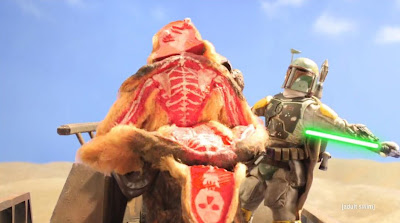Four lines. Twenty-seven words. Ninety-one characters. However you want to put it, Boba Fett isn’t the most prolific character in the Star Wars mythos. Detractors are quick to point out that despite his immense popularity, Boba’s role in the original trilogy amounts to tracking the Millennium Falcon, hanging out with Vader, and then acting like a moron at the Pit of Carkoon. He isn’t even referred to by name until Return of the Jedi. A combination of Lucasfilm marketing and fan anticipation put Boba Fett on an unattainable pedestal of cool, but ultimately he was a side character whose only purpose in the story (thus far) was to take Han Solo out of the equation. He looks awesome, but for most viewers the fascination stops there.
So why the hell am I taking the time to write a blog about this guy?
 |
| Because he looks really awesome! Duh! |
Mass media summaries of the enduring popularity of Star Wars almost always cite the series’ black-and-white spectrum of morality. Apparently none of those journalists have watched the films, because the difference between good and evil in Star Wars couldn’t be farther from crystal-clear. The only film in the series with a binary depiction of light and dark is A New Hope; all subsequent sequels and prequels have dealt consistently with the concept that everyone has the inherent potential to do right or wrong, and that it is our own choices that define us.
The moral struggle in Star Wars is played out most powerfully between Darth Vader and Luke, particularly at the climax of Empire, when Luke discovers that his ultimate nemesis is the very man he was seeking to avenge. The audience’s understanding of the film’s morality is thrown out the window at this point. We are left to overcome the numerous psychological quandaries and obstacles that have been thrown into the mix. This is an especially sophisticated challenge for Star Wars’ intended audience – children.
After being introduced to The Empire Strikes Back, I chose to believe with all the finality my five year old heart could muster that Vader was a liar. Vader was the bad guy and lying was what he was best at – he just wanted to trick Luke into joining the dark side. It wasn’t true. It was impossible.
As I replayed the film in my mind, looking for answers, I latched on to another character whose shades of grey were much easier to relate to: Boba Fett.
 |
| Search your feelings. You know it to be true. |
Still in denial over Vader’s reveal, I embraced him.
Twenty-two years later, enter Jango Fett.
It was a masterstroke on Lucas’ part to position Jango Fett as both the template for the clone army and the father of Boba Fett. Until Attack of the Clones, Boba had no real significance beyond being able to pursue Han Solo. The prequels change that.
By creating Jango Fett, Lucas transferred a twenty year backlog of accumulated moral ambiguity to the father of the clones. The prequels are set in a far more morally complicated era than the original trilogy, comprised of tragically flawed protagonists and decoy villains: Lucas required an even more extreme factor to make the audience focus on the particular ambiguity surrounding the clones. Had the clone template been some wholly new character, the audience would quickly identify the clones as evil characters, based on the degree to which they resemble Stormtroopers.
But because the clones have a shared heritage with Boba Fett, we subconsciously grant them a measure of moral neutrality, and a badass quality by proxy.
Finally we learn the mysterious origin of Boba Fett: he was a rogue clone created alongside the first generation armies of the Clone Wars. Aside from tying together some interesting threads in Star Wars mythology, this plot point also provides us with the saga’s secondary father-son relationship. Jango and Boba can't help but mirror Vader and Luke. Bloodthirsty profession aside, Jango shows every sign of having a healthy relationship with his young son, especially in comparison to the ever-dysfunctional Skywalker clan. This gives Jango a new emotional dimension and makes him into more than Christopher Lee’s silent yojimbo. The highly masculine elements of Jango’s character are balanced out by the feminine aspect of child-nurturing. The guy is no saint, but at the very least he’s a multi-faceted human being. The antiseptic Kaminoans wring that humanity out of his DNA to spawn emotionless, identical soldiers devoid of that feminine principle. Boba Fett has no mother, while Anakin Skywalker has no father. The troubled destinies of these two men highlight the lack of balance between masculinity and femininity in their unusual conceptions.
Jango’s death also gives Boba Fett a classic Western character motivation: child witnesses parent's murder and grows up seeking vengeance, following personal code of justice, scarred for life. In a faintly heartbreaking shot, Boba picks up his dead father's helmet and symbolically assumes Jango’s role as the galaxy’s most proficient mercenary - unlike Luke Skywalker, who is spared from witnessing his own father's tragic downfall at an early age. Luke has the benefit of maturity when he learns the truth about his lineage, allowing him to resist taking on the mantle of Anakin’s black armour. Luke chooses his own path: the true son, instead of a clone of his father.
Boba Fett is the recurring symbol of moral ambiguity in Star Wars, ignoring the meridian between light and dark entirely. The Fett dynasty is the direct counterpart and mirror image of the Skywalkers on every level.
All in all, not bad for a guy with four lines.











































